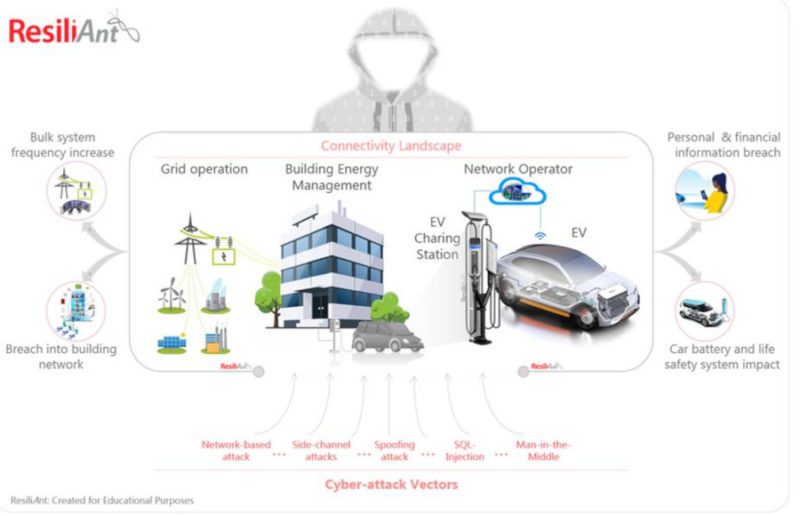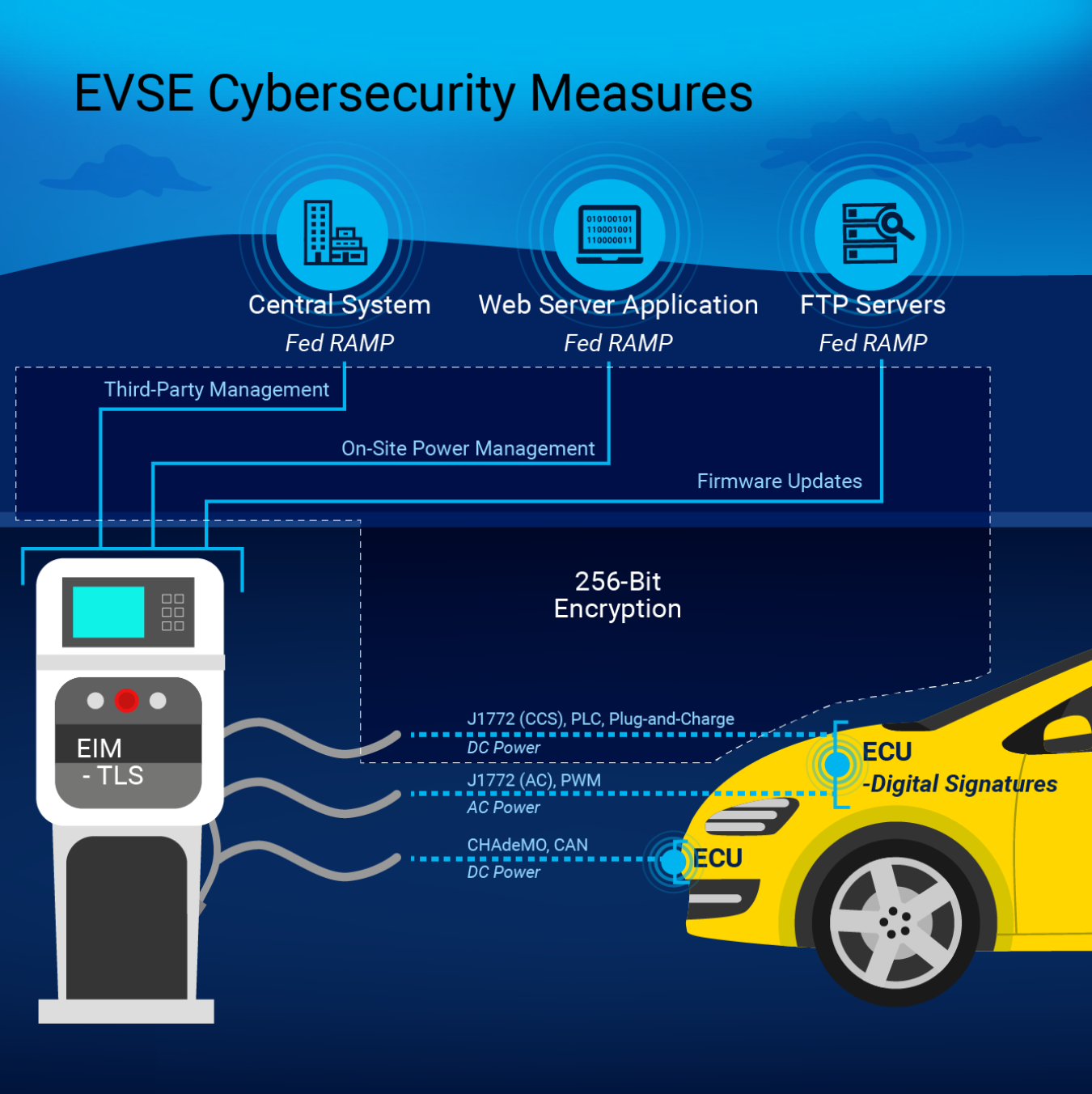As electric cars evolve from novelty to necessity, their software complexity and internet connectivity increase, adding another layer of concern: cybersecurity. As our vehicles become extensions of our digital lives, they also become potential gateways for cyberattacks. Is your trusty ride wheeling toward becoming a sophisticated, susceptible gadget on wheels? It’s time we steer into the details of electric car connectivity, their cybersecurity, and the means to safeguard our high-tech horsepower. Strap in. Only in this case, we’re not safeguarding against physical theft, but a digital one.
Exploring the Concept of Electric Cars

Let’s first get under the hood of electric cars – what they’re really about. These sleek machines are powered by electricity, stored in high-powered batteries rather than the conventional gasoline or diesel. The torque put out by the electric motors is instant, making for athletic takeoffs that leave internal-combustion competitors fumbling with gears.
In terms of hardware, the electric car comes with fewer moving parts than your average gas guzzler. Less complexity means fewer things can go wrong, less time and money spent on maintenance, and the silent operation of the vehicle is just icing on the cake. You’ll quickly find sipping on a cup of coffee and listening to your favorite tunes takes on a new definition in the tranquil environment of an electric vehicle.
But let’s not stray from the fact that not all the magic lies on the extreme ends of the performance chart. There’s also a crucial middle ground where electric cars shine – in the realm of connectivity and data. The concept extends deeper than built-in GPS systems and handy Bluetooth pairing. Electric cars are essentially rolling computers. They come equipped with sophisticated systems for data communication, including connecting to the internet and other devices, performing diagnostics, updating software, and more.
This connectivity, while boosting convenience and functionality, also opens a potential Pandora’s box of cyber security threats. You see, munching on power and putting all that torque to asphalt isn’t the vehicle’s sole purpose anymore. In addition, it’s now responsible for processing and protecting large volumes of data, fending off potential cyber-attacks or hackers who might be chomping at the bit to exploit any possible vulnerabilities.
In summary, the electric car, in all its whirring majesty, stands not just as a testament to technological advancement, but also a new frontier for cybersecurity in the automotive sector. It’s a realm where beauty meets prowess meets virtual threat landscapes. It’s a story of exhilarating speed, supreme efficiency, and yes, potential vulnerabilities if not handled with due diligence. Thus, as they surge into the mainstream, the need for robust cybersecurity measures in electric cars becomes increasingly vital. Hang tight, as we delve deeper into this topic in coming sections.
Cybersecurity and Its Importance in Electric Cars

With electric cars becoming a significant player in the automotive industry, cybersecurity has become an integral concern. These eco-friendly machines come equipped with an extensive array of networked electronics, including Wi-Fi, Bluetooth, and cellular connectivity, enhancing comfort and convenience for drivers. But as futuristic and beneficial as these functionalities may seem, they represent potential entry points for hackers.
The emphasis on cybersecurity in electric vehicles cannot be overstated. Electric cars are dependent on software control for functions like battery management, GPS navigation, infotainment, and even autonomous driving capabilities. A breach in any of these could lead to severe consequences, which could not just threaten the vehicle’s performance or the owner’s privacy, but also the passengers’ safety.
Imagine never having to key in a destination to your GPS because your car knows your daily routine, or your vehicle knowing when you’re five minutes from home and turning on the house lights for you. Now, picture a hacker understanding that same routine and having control over your vehicle. Pretty intimidating, right? That’s why cybersecurity is essential.
The possibility of electric vehicles being hacked isn’t a far-off, dystopian future. It’s a present-day reality. For example, researchers in the past have been able to disable a car’s brakes, turn the steering wheel, or suddenly kill the engine. While these were controlled experiments with willing participants, the results demonstrate the extent of damage a malicious hacker could inflict.
In essence, cybersecurity is imperative in electric cars because these vehicles are more than just machines built for transport. They are interconnected nodes in the Internet of Things, constantly sharing, receiving, and storing sensitive information. So, the next time you marvel at an electric car’s cutting-edge technology and opulence, spare a thought for the silent guardian – cybersecurity – that keeps it all running smooth and safe.
Vulnerabilities in Electric Cars

When discussing electric vehicles and their intersection with cybersecurity, we can’t turn a blind eye to the glaring vulnerabilities that these machines may bear. Given our deepening reliance on technology, these vulnerabilities aren’t merely consigned to the realm of filmdom’s science fiction. They present a very real threat that merits our scrutiny and understanding if we’re to get ahead of them.
First up, it’s essential to understand that these aren’t your grandpap’s Cadillacs. Modern electric vehicles are essentially computers on wheels, heavily reliant on internet connectivity. This connectivity forms the backbone of several key vehicle features such as navigation systems, remote control functions, over-the-air software updates, and more. However, the same thing that makes electric cars smart, acts as an Achilles heel, opening up an expansive spectrum of attack vectors for malicious hackers to exploit.
Hackers, well-armed with increasingly sophisticated techniques, can potentially penetrate the vehicle’s system through its telematic control unit (TCU), Onboard Diagnostic Port (OBD-II Port), infotainment system, mobile applications, and more. Once inside, they could potentially seize control of the vehicle’s key functionalities such as the propulsion system, steering, and braking. While a worst-case scenario, there is a tangible risk of such unauthorized access leading to accidents and posing significant threats to passenger safety.
Moreover, from a broader perspective, the threat isn’t just limited to carjacking. The data that electric vehicles collect, such as the owner’s driving habits, their schedule, and frequent locations, is a goldmine for enthusiastic hackers. With cases of data breaches becoming commonplace, a hacker potentially has access to a battery of information just by breaching one’s car’s system.
Inevitably, this discussion leads us to consider the possibility of electric vehicle charging stations as potential hotspots for cyber threats. Current infrastructure allows for data transfer between the charger and the vehicle, which turns the charging station into another vulnerable point of entry for cybercriminals.
Recognizing these threats is the first step to combating them. By appreciating the gravity of these vulnerabilities, tighter security protocols can be implemented to further bulletproof our evolution towards an exhaust-free future.
Strategies to Improve Cybersecurity in Electric Cars
Imagine this: you’re cruising down a scenic highway in your new electric vehicle, enjoying the harmony of sustainable engineering, when suddenly, your car gets hijacked. Not by a traditional carjacker, but by a hacker breaching your vehicle’s digital defenses. Sounds like a futuristic nightmare, huh? Well, it could become a reality if cybersecurity measures for electric vehicles aren’t upped. So, here we’ll discuss strategies on how to fortify the said cybersecurity.
Firstly, it all starts with responsible programming and development. It sounds simplistic, but incorporating security into the design of digital systems of electric vehicles from the outset is crucial. Developers need to be hyper-aware of the potential security risks in their code and actively work to negate them. This involves regular rigorous testing for vulnerabilities before, during and after the programming phase.
Secondly, we should focus on multi-layered security systems. Moving past the era of one-dimensional firewalls, today’s electric vehicles need more robust multilayers of defense. This includes an array of measures, such as Intrusion Detection Systems (IDS) which would serve as e-watchdogs, monitoring system activity for malicious actions or policy violations. Improved encryption methods are also a must, to protect data traveling between the vehicle and the grid from potential breaches.
Thirdly, we can’t overemphasize the importance of regular software update schedules. We’ve all clicked that “remind me later” button at least once when prompted to update software. But that small action may leave gaping security holes for hackers. Regular software updates fix these problems and introduce new or improved features that can make the system more secure against cyber threats.
Fourth on the list is user education. Many cybersecurity vulnerabilities arise from human error, ignorance or negligence. Car companies need to invest in educating electric car owners about the cyber threats that could affect them and their vehicles. From good password habits to how to detect phishing attempts, awareness could go a long way in securing these green machines.
Finally, collaboration is key. Cybersecurity is not merely an issue for car manufacturers or software developers to grapple with in isolation. Utilities, charging station manufacturers, security firms, and government agencies must all work in unison. Initiatives can be taken within the industry to design common security standards, share threat intelligence, and collaborate on effective defense strategies.
Electric vehicles represent not just an environmental breakthrough, but also a technological one. As they become more prevalent on our roads, the need for robust cybersecurity measures will continue to grow. This list of strategies is by no means exhaustive, but it underscores the commitment and collaborative efforts needed for progress. The road to robust cybersecurity in electric vehicles may be arduous, but it is undeniably necessary.
Case Studies: Successes and Failures in Electric Car Cybersecurity
Peeling back the pages of history presents a mixed bag of triumphs and mishaps in the quest for secure connectivity in electric vehicles. Let’s time travel to 2015, when two hackers, by the names of Miller and Valasek, demonstrated that the firmware of a Jeep could be exploited through the entertainment system, thus allowing them remote control over the automobile. This hair-raising moment underscored a gaping chink in the armor of cybersecurity in electric cars – one that sent shockwaves through the industry.
Fortunately, the tale does not end on this somber note. Take the case of Tesla, a marquee name in electric vehicles. In 2016, a team of Chinese hackers known as the Keen Security Lab identified vulnerabilities in the Tesla Model S, which could have potentially allowed attackers to control the vehicle remotely. Tesla, with its established bug bounty program and commitment to addressing identified issues, quickly rectified these weaknesses. This swift action is a commendable testament to Tesla’s proactive role in ensuring their electric vehicles’ cybersecurity.
Yet, the 2018 episode with the Nissan Leaf left a stain on the fabric of electric car cybersecurity. A security researcher found that the model’s companion app could be exploited to access data about the car’s operations and even control certain features. This inattention to cybersecurity in electric vehicles drew a fair amount of criticism and was a warning to the industry about the importance of secure communication channels and tested software.
In contrast, the response of BMW to a similar situation stands out. In 2015, the German Automobile Association identified a flaw that allowed hackers to unlock the doors of several models remotely. BMW, displaying proactive responsibility, patched these vulnerabilities by implementing HTTPS and increased data encryption, thereby gearing up its 2.2 million affected automobiles with heightened cyber defenses.
Drawing inspiration from these examples, it’s clear that an active, attentive, and agile stance toward cybersecurity in electric vehicles is critical. Setbacks have played the crucial role of alarm bells; their distinct clang underscores the urgency and importance of incorporating robust security measures in electric vehicle designs and operations. On the flip side, the triumphs underscore the vast potential of electric vehicles when armed with steadfast cyber defense mechanisms. The journey to ensuring safe connectivity in electric cars is certainly a winding one – filled with mountains to climb and valleys to traverse – but each step, whether a stumble or a stride, propels the industry forward.
Future of Cybersecurity in Electric Cars

As we cruise ahead full-throttle to an electrified future, it’s clear that cybersecurity will be taking up shotgun as a significant component of the drive. While the thrill of what EVs will bring is almost intoxicating — with their promise of zero-emission travel, revolutionized fuel efficiency, AI driving functions, and smart connectivity — there are crucial factors to keep in mind. The electrification of the auto industry is inevitably intertwined with the digital realm, bringing the future of cybersecurity to the forefront.
Electric cars are essentially computers on wheels. Beyond the mechanical base, a collection of microprocessors, sensors, and software code give it the ‘juice’. However, just as with any internet-connected device, the potential for cyber threats is real. As EVs continue to evolve, so too will the complexity and sophistication of these threats. The concept of an EV being hacked while in motion used to be science fiction, but the reality is that it’s becoming increasingly conceivable.
This brings us to the hulking question: what does the future of cybersecurity in electric cars look like? The answer isn’t a single remedy. Rather, it involves a synergistic approach that evolves with the shifting landscape of threats.
We can expect vehicle manufacturers and cybersecurity firms to work more closely together. The aim will be to ensure embedded vehicle systems are secure by design, from the very inception of an electric vehicle’s lifecycle. Earlier integration of cybersecurity within the production cycle can catch potential vulnerabilities before deployment, making prevention as much the focus as mitigation.
Car manufacturers are also likely to implement multi-layered cybersecurity strategies. Just like the defensive layers of an onion, these would safeguard various systems within an electric vehicle. Even if a single layer was breached, multiple other barriers would still stand between the cybercriminal and the car’s core functionalities.
Furthermore, it’s anticipated that the leveraging of AI and machine learning will be ramped up. These technologies can help in detecting, preventing, and responding to cyber threats, especially as those threats become more complex and insidious.
There’s also a critical role for regulations and standards in shaping the future of cybersecurity in electric cars. Establishing specific security measures that manufacturers are obligated to adhere to forms part of this picture. As part of a wider culture of information sharing, anonymized data from detected threats could be shared among auto companies to bolster industry-wide defenses.
In essence, the electrifying future of cars is a double-edged sword. It offers the appeal of innovation and environmental responsibility but harbors the risk of cyber threats. However, with careful consideration and multifaceted cybersecurity strategies, the ride towards this future doesn’t have to be perilous. The key is understanding that cybersecurity in electric cars isn’t a destination but a journey — one that requires continuous evolution and proactive defense.
FAQs
Are electric cars vulnerable to cyber attacks?
What are manufacturers doing to ensure cybersecurity in electric vehicles?
How can I ensure my electric car stays safe from cyber attacks?
Conclusion
As we embrace electric motoring and its exciting possibilities, it is paramount we face the challenges head-on, regarding cybersecurity as a prime pillar of this technological revolution. The balance between high-speed connectivity, functionality, and security is not optional, but absolutely necessary. The next generation of electric vehicles promises a smooth, secure, and, indeed, electrifying journey. Let’s ensure they deliver on that promise. The future on wheels is electric; let’s make it safe too.
